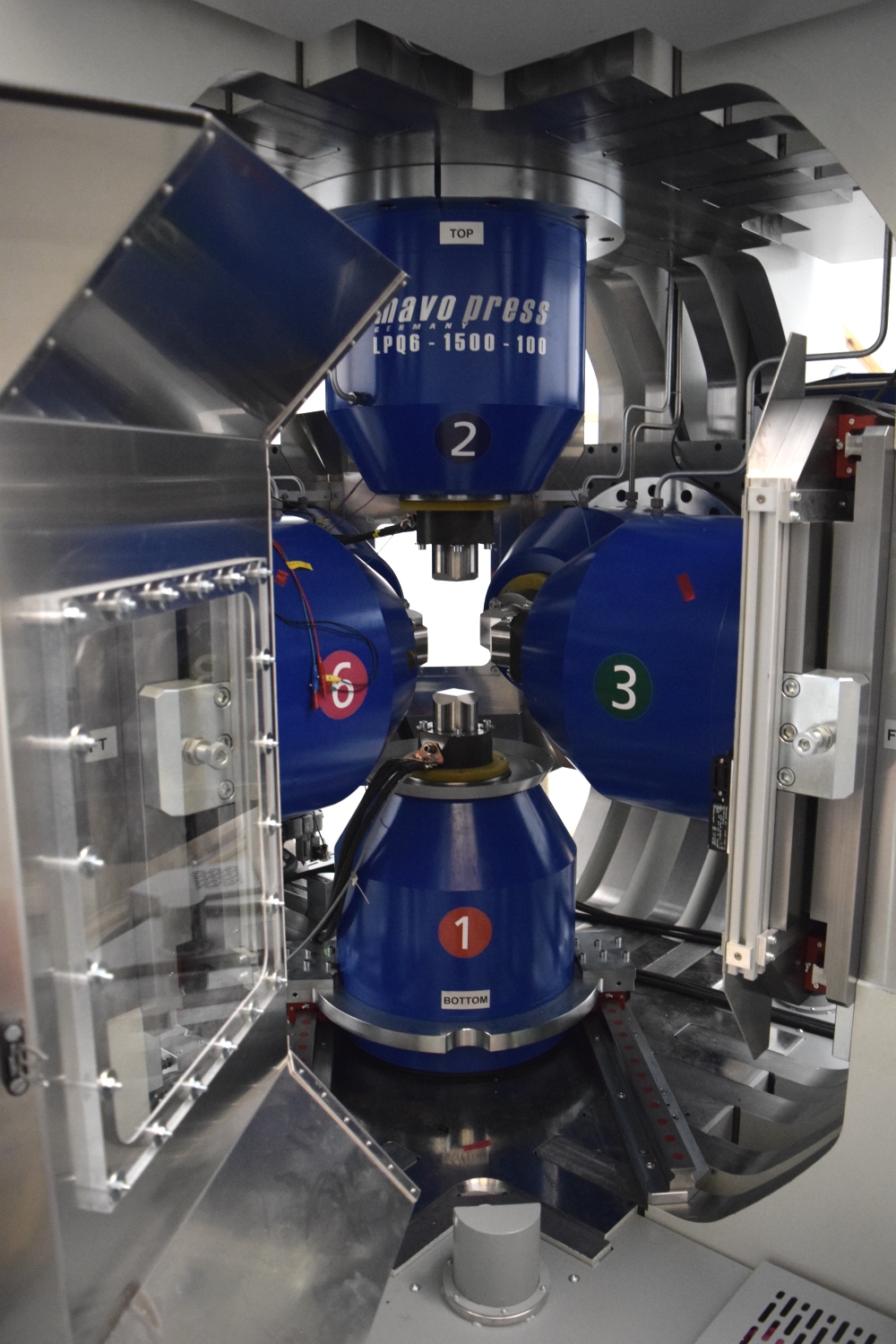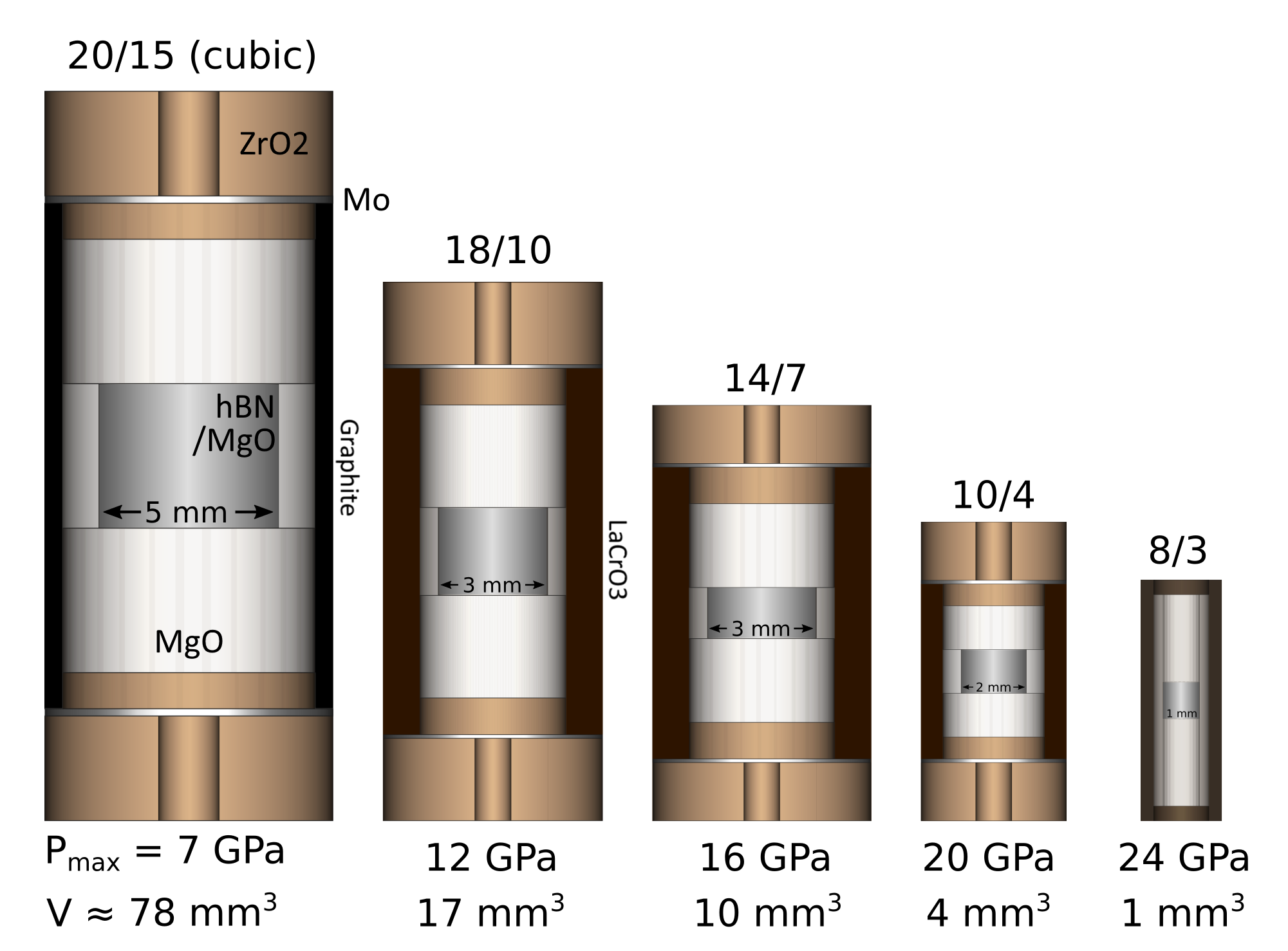Beamline P61 is divided into 2 stations - P61A (HZG) and P61B (DESY). Operation of these two different stations using synchrotron X-rays is not independent and beamtime is shared 50%. P61B, the Large Volume Press portion of the beamline, also operates without beam for ex situ studies at extreme conditions when P61A is operating with beam. The beamline is fully operational with X-rays at both stations.
The 10 wigglers (ID) provide synchrotron X-ray radiation with a usable energy range of 30 - 200 keV (photons with even higher energies exist, of course). The beamline is designed for the combination of Energy-dispersive X-ray diffraction (ED-XRD), Angle-dispersive X-ray diffraction (AD-XRD) and Imaging techniques (radiography/absorption contrast). Note that AD-XRD is currently not implemented until the respective beamline stations each obtain a monochromator.
Research at P61A focuses on engineering materials science. The structure-properties relationship in technically relevant materials is studied. In-situ experiments for investigations of materials and processes are designed and built together with internal and external partners. The method applied is energy-dispersive diffraction at high photon energies enabeling, e.g., near-surface and bulk residual stress and phase analysis with a fixed gauge volume and fixed scattering vector. Furthermore, complex sample environments can profit from a fixed scattering vector.
Research at P61B is focused on extreme conditions materials and Earth science. The structure and properties of samples can be measured in situ using these techniques under extreme conditions of high pressures and temperatures using ED-XRD and radiography. Various combinations and additional set ups are already available such as ultrasonic interferometry and acoustic emissions detection, with more planned in the future. Please visit the official PETRA III website of the end-station P61B for more information.
News
- For experimental time using the LVP, please visit the P61B webpage at Photon Science at DESY.
- P61B LVP (DESY) started user runs in II-2020.
- P61A (HZG) started first user runs in December 2020.
470 [eV] @ 122000 [eV]
Damping wiggler
The distance of the last wiggler to the Optics Hutch of P61A is about 110 m.
The distance of the last wiggler to the Optics Hutch of P61B is about 133 m.
Front end filters
1x CVD-diamond (0.3 mm) & Cu (0.05 mm) - MANDATORY
2x CVD-diamond (0.6 mm) & Cu (0.1 mm)
3x CVD-diamond (0.9 mm) & Cu (0.15 mm)
plus 4 mm C (with various combinations of the above)
Slits
Tunable Absorber
P61A - Heavy load diffractometer
Sample
P61B - Large Volume Press (LVP)
 The LVP that is installed at P61B is the world’s first 6-rams-LVP operated at a synchrotron facility. This type of instrument offers deformation capability, precise control of the anvil positions and high efficiency of pressure generation. Experiments at extreme conditions of high pressures and temperatures are possible in various modes using a combination of 6 first-stage anvils and 6 or 8 second-stage anvils (6-6 and 6-8 compression geometries, respectively). Using the 6-8 mode with tungsten carbide second stage anvils, pressures up to 24 GPa and temperatures up to 2,400 K can be routinely generated at the expense of a smaller anvil gap, up to 10 degrees for diffracted X-rays. The user may bring their own set ups using advanced, ultra-hard and tapered WC anvils to generate even higher pressures up to > 40 GPa combined with high-temperatures (> 2,000 K), and beyond 60 GPa using sintered diamond anvils. Alternatively, the 6-6 mode offers a wider anvil gap, particularly up to 23 degrees in the vertical plane for X-ray diffraction, but the maximum sample pressure is limited to about 20 GPa using a regular set up. Controlled deformation (anisotropic compression) of samples is only possible in 6-6 mode.
The LVP that is installed at P61B is the world’s first 6-rams-LVP operated at a synchrotron facility. This type of instrument offers deformation capability, precise control of the anvil positions and high efficiency of pressure generation. Experiments at extreme conditions of high pressures and temperatures are possible in various modes using a combination of 6 first-stage anvils and 6 or 8 second-stage anvils (6-6 and 6-8 compression geometries, respectively). Using the 6-8 mode with tungsten carbide second stage anvils, pressures up to 24 GPa and temperatures up to 2,400 K can be routinely generated at the expense of a smaller anvil gap, up to 10 degrees for diffracted X-rays. The user may bring their own set ups using advanced, ultra-hard and tapered WC anvils to generate even higher pressures up to > 40 GPa combined with high-temperatures (> 2,000 K), and beyond 60 GPa using sintered diamond anvils. Alternatively, the 6-6 mode offers a wider anvil gap, particularly up to 23 degrees in the vertical plane for X-ray diffraction, but the maximum sample pressure is limited to about 20 GPa using a regular set up. Controlled deformation (anisotropic compression) of samples is only possible in 6-6 mode.sCMOS camera
Sample

Techniques usage
Sample Environment
HP Ge-detector
Detection
sCMOS camera
Detection
P61B - Sample Preparation Lab
P61B has a dedicated sample preparation laboratory for users on the beamline. It is fully equipped to build cell assemblies and anvil configurations for the LVP. Sample powders can be encapsulated with metal foils using various tools and jigs, and welded if required using a precision jewelry welder. Starting materials can also be synthesised or treated in the available high temperature (1400 C), vacuum furnace (> 10-5 mbar).
Special requests
Prior to your arrival, please contact the beamline manager (Robert Farla) for special requests using the 3-axis CNC to make cell assembly parts from various ceramics.
- Powder diffraction
- Surface diffraction
- Time-resolved studies
- Topography
- Medical application
- X-ray microscopy
- X-ray tomography
- Elastic scattering
- Time-resolved scattering
- Wide angle scattering
- Physical Chemistry
- Geology
- Mineralogy
- Natural disaster, Desertification & Pollution
- Other - Earth Sciences & Environment
- Water sciences/Hydrology
- Technique Development - Energy
- Aeronautics
- Other - Engineering & Technology
- Technique Development - Engineering & Technology
- Medicine
- Technique Development - Life Sciences & Biotech
- Knowledge based multifunctional materials
- Metallurgy
- Other - Material Sciences
- Technique Development - Material Sciences
- Hard condensed matter - structures
- Surfaces, interfaces and thin films
- Technique Development - Physics
Build. 46g (Peter Paul Ewald Hall)
Notkestr. 85
D-22607 Hamburg, Germany
- Tango
- Energy spectra, images
- HDF5, TIF
- e.g. PDindexer (http://pmsl.planet.sci.kobe-u.ac.jp/~seto/)
P61B - Anvils and pre-made cell assemblies
